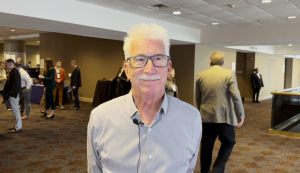With ‘above normal’ hurricanes ahead, Florida cities ready tech response

Hurricane season in the Atlantic Ocean officially began on June 1, and with National Weather Service forecasters predicting storm activity to be “above normal” this season, some Florida cities are readying technologies that can help with response.
Strong storms can knock out power lines and cell towers and interrupt internet service, putting the cloud-based technologies used by emergency dispatch units and first responders at risk. But some Florida cities are adding layers of technology that can work under these limiting conditions.
The Miami suburb of Coral Gables upgraded to a cloud-based computer-aided dispatch platform, which provides redundancy to ensure its 911 never goes down. Tampa expanded its collection of mass communication tools, layering methods of outreach so even if there’s no cell service or internet, emergency management officials and residents can still access and exchange crucial information in the event of life-threatening situations.
Ed Hudak, the Coral Gables chief of police, told StateScoop that having a cloud-based system means one less worry during a catastrophic event like a hurricane or cyberattack.
As part of Coral Gables’ effort to make its systems redundant, Hudak said, the city recently built a public safety building, which now houses the city’s police department, fire department and emergency operations center. Previously, the departments were located in different buildings. Hudak said the physical consolidation allows the entire city to use one server, easing the ability of fire, police and emergency systems to communicate with one another during severe weather.
“As long as you have power, which could be a generator, you’re going to have connectivity,” Hudak said. “I don’t have to worry about my servers getting blown up, if in fact we have some kind of breach at the building. And we have two huge generators, so I won’t lose power there.”
Hudak said his department also recently designed a satellite truck that allows law enforcement to access its primary or backup dispatch systems from anywhere in the state.
“This truck also has three types of redundancy, so it can talk through cell phones, it can talk through satellites and it can talk through regular hard lines,” he said. “We have been able to basically flip the switch and have those conversations, which is important when it comes to public safety.”
‘Multiple teams, to multiple facilities’
In Florida, severe storms that produce catastrophic devastation live in recent memory. In September 2022, Hurricane Ian made landfall in southwestern Florida at Category 4 storm, producing catastrophic storm surge, damaging winds of up to 156 mph and historic flooding across the central and northern parts of the state.
According to NOAA’s report on Ian, the storm was responsible for more than 150 direct and indirect deaths in Florida and $112 billion in damage, making it the costliest hurricane in state history and the third-costliest in United States history.
Eric Hayden, Tampa’s chief information officer, told StateScoop that preparations in the city happen year-round with table-top exercises and trainings. But communications, he said, are the “number one priority” for command and control, as well as for situational and community awareness during the city’s natural disaster response. And as in Coral Gables, Tampa is focusing on redundancy by operating back-up dispatch facilities.
“We can also relocate our 911 groups, the actual teams, to multiple facilities,” Hayden said. “They can actually operate from their hardened facility they’re in today. But we also have another hardened facility that if they lose their primary facility, or any component of it, we can actually safely move them to another facility, and they can continue dispatching 24 hours a day. So instead of having a secondary application, we have multiple locations with the same application duplicated.”
Hayden said his department’s internal communications portal, WebEOC, allows city officials to communicate with other agencies in the state. Even if power is lost during a hurricane, Hayden said, the system ensures Tampa doesn’t lose contact with the rest of the state.
Other tools include real-time vehicle location tracking, which response teams can use to report progress if they’re clearing debris, information city officials can share with the public. The city also has radios that operate on non-emergency spectrums, if all else fails.
“Let’s say we lose cellular communications, or telephone communications or internet for a lot of the communities, then we also have ham radios throughout the region so that we can get messages back and forth to neighborhoods and communities,” Hayden said.
For communicating with the public during emergencies, Hayden said the city relies on partnerships with local news stations and uses AlertTampa, an alert system that sends texts, calls and emails to citizens.
But one of the most important pieces of the city’s response in the event of system failure, Hayden said, doesn’t involve technology at all.
“We have neighborhood canvassing teams, which means those are our teams that are actually deployed in the neighborhoods and they go door to door and they post information,” he said. “It’s things like ‘tune into this channel,’ or in case major outlets are down, we can actually tell them where to look for something else.”
‘So many layers’
Floridians are concerned about the potential for technology to fail during catastrophic weather. In a recent survey by the software company Mark43, 81% of Floridians said they didn’t get immediate help during extreme weather.
Seventy-nine percent of Florida residents surveyed said they support increasing federal funding to local public safety agencies for technology upgrades. Eighty-one percent said their local law enforcement agencies should prioritize tech upgrades, and 85% said they support more spending on emergency preparedness tools.
NOAA’s forecast for this season includes between eight to 13 storm systems that are predicted to become hurricanes, meaning they feature winds of 74 mph or faster. The weather agency predicts four to seven of those storms will become major hurricanes.
“Severe weather and emergencies can happen at any moment, which is why individuals and communities need to be prepared today,” FEMA Deputy Administrator Erik Hooks said as part of NOAA’s forecast last month. “Already, we are seeing storms move across the country that can bring additional hazards like tornadoes, flooding and hail. Taking a proactive approach to our increasingly challenging climate landscape today can make a difference in how people can recover tomorrow.”
Hayden said he feels confident that Tampa has taken a proactive approach, but that no technology upgrade can guarantee safety in the face of natural disasters.
“We expect a lot of this tech to stop,” Hayden said. “That’s why we have so many layers of it. We have our online portals, we have our offline portals, we have our ham radios, we have our regular public radios. All of those together provide multi-layered protection.”
Corrected June 20, 2024: This story previously incorrectly stated that Coral Gables was using a backup CAD system.



